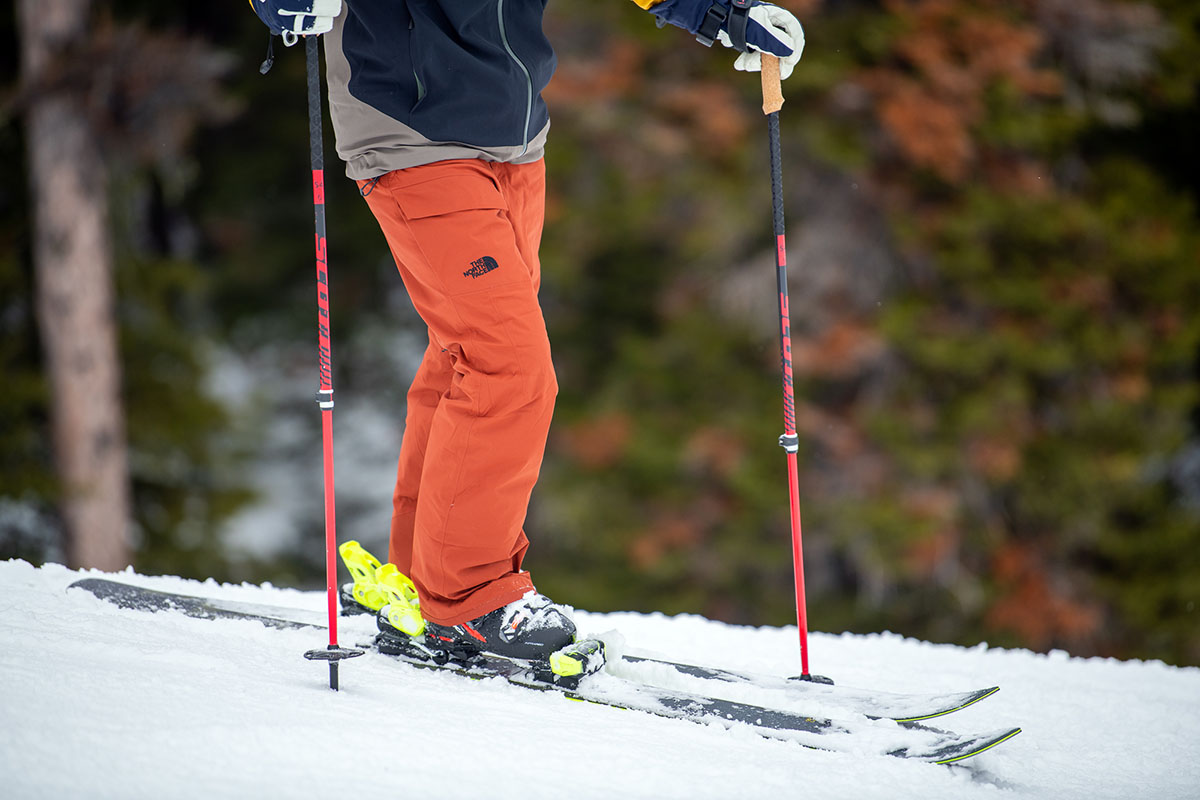
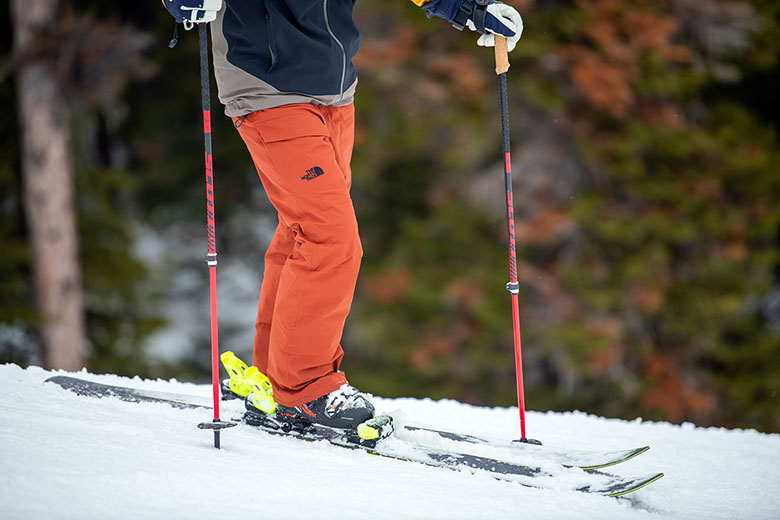
Switchback Travel (Jason Hummel)
Ski pants are a critical barrier between you and the elements, and there’s a pair to fit every type of skier and budget. Resort-goers typically opt for a classic hardshell design with some light insulation to stay warm on the lift rides up. Backcountry riders have plenty of softshell and stretch-infused options for improved range of motion and breathability. Of course, some of our recommended ski pants toe the line for those who like to do a little of both. Below are the best ski pants for the 2025 season. For more background information, see our comparison tables and buying advice below the picks, along with details about our testing process. Of note: This article includes options for both men and women, but we’ve also written dedicated round-ups on the best women’s ski pants and best men's ski pants.
Editor’s note: We updated this guide on March 6, 2025, to revamp our buying advice section. To reflect the guide's unisex focus, we also tweaked several product listings by linking to both the men's and women's versions (when applicable).
 Best for: Resort and backcountry
Best for: Resort and backcountry
Type: Hardshell
Insulated: No (thin flannel backer)
What we like: Fantastic build quality, weather protection, and versatility.
What we don’t: Expensive; fit intricacies with the last couple versions.
If we were to pick one ski pant for anywhere on the mountain, for conditions from bluebird to overcast and wet, it would be the Arc’teryx Sabre for men and Sentinel for women (below). These pants nearly have it all: 80-denier (D), 3-layer Gore-Tex for bomber protection from the elements, a lightweight flannel backer for comfort and a touch of warmth, and a solid feature set with plenty of storage. Attention to detail is also a Sabre hallmark, and the light-yet-burly construction is a nice break from the overly heavy and bulky feel that you get with most ski pants. As with most Arc’teryx gear, price is the biggest obstacle, and this is a significant investment if you don’t plan to get out a lot (one of the budget options below may be better for those who only ski occasionally).
The Sabre is an excellent choice for active resort skiers and those who like to venture beyond the ropes into the sidecountry. These pants won’t be out of place during trips in the backcountry either, with fantastic range of motion, along with big side vents for dumping heat. That said, Arc’teryx tweaked the fit a couple seasons ago, and we weren't fans: Both our testers at the time complained of a short rise and shorter-than-expected inseam. After checking out the most current 2024/25 version, we can report that the fit is still polarizing. The pants run small (so size up if you're on the fence), and the cut is very straight/athletic through the thighs and backside. Of note: Arc’teryx does now offer a Relaxed version with a roomier fit, along with a higher-riding bib design. Regardless of which option you choose, the Sabre is a truly high-quality and versatile offering from the venerable Canadian brand, earning it our top spot for yet another season.
Read more: men's Arc'teryx Sabre Pant review (prior version)
See the Men's Arc'teryx Sabre Pant

 Best for: Resort and backcountry
Best for: Resort and backcountry
Type: Hardshell
Insulated: No (thin flannel backer)
What we like: Class-leading fit, comfort, styling, and performance both in and out of bounds.
What we don’t: Arc'teryx quality comes at a steep cost—and not everyone needs this level of performance.
Arc'teryx's Sentinel is the women’s counterpart to the Sabre above and shares many of the same beloved features. Like the Sabre, the Sentinel is a great crossover option for those who split their time between the resort and backcountry. You get a durable, 3-layer Gore-Tex construction (also 80D) that provides dependable protection in wet and blustery weather and stands up well to frequent chairlift rides and tree skiing. The lightweight flannel backer offers a nice dose of coziness without being overwhelming on the skin track, while the generous side vents make it easy to dump excess heat. Finally, while the Sentinel shares the Sabre's athletic fit, we appreciate that it comes in three inseam lengths for more easily tailoring fit, along with an insulated model for those who run cold or ski in particularly frigid climates (plus the same relaxed and bib variations to round out the collection).
However, like most Arc’teryx gear, the Sentinel is undeniably spendy at $600. If you’re primarily a resort skier, you can save a lot by stepping down to a 2-layer design like Patagonia’s Insulated Powder Town Pants (which also come in a non-insulated version) or REI’s First Chair GTX Bibs below. You can expect to make sacrifices in breathability and comfort, but new or occasional riders will likely find the price savings worth those trade-offs. Alternatively, if you spend most of your time in the mountains, it may be worth considering Black Diamond’s Recon Stretch below, which will save you $200 but falls short in protection and overall refinement. In the end, it’s hard to knock Arc’teryx’s level of quality—it certainly comes at a price, but there’s no denying the Sentinel’s top-notch craftsmanship and all-around performance.
See the Women's Arc'teryx Sentinel Pant

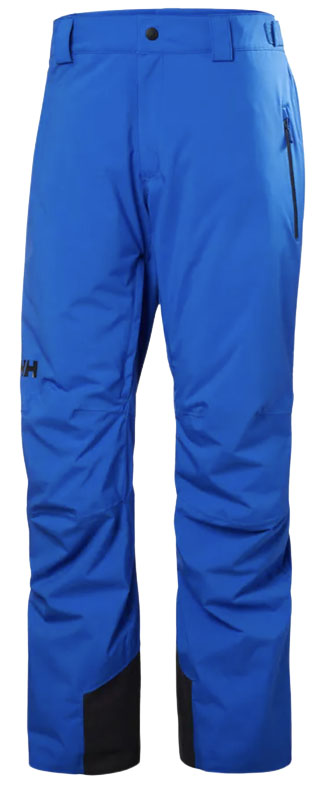 Best for: Resort
Best for: Resort
Type: Hardshell w/ stretch
Insulated: Yes (60g PrimaLoft)
What we like: Just-right warmth, stretchy and comfortable fit, and great price.
What we don’t: Material is prone to showing wear over time.
Dedicated resort riders—especially those who live in cold climates like the Northeast or Midwest of the U.S.—might find insulated ski pants appealing. Though they lack the versatility of uninsulated designs (you can't tailor warmth depending on conditions), insulated pants will undoubtedly keep you comfortable on cold chairlift rides, in long lift lines, and when skiing downhill on frigid days. For a super clean insulated pant with a great fit and just-right warmth, give the Legendary from Helly Hansen a look. The 2-layer waterproof shell is ideal for those who aren’t frequently working up a sweat—and helps keep costs in check—and the PrimaLoft insulation provides excellent warmth on bitter days. We also like the lightweight feel and simple design from the Norwegian company, which comes in a variety of classy colorways to match just about any ski jacket.
In terms of mobility, the Legendary incorporates mechanical stretch into the fabric that offers extra "give," which is great for both sidecountry hikes and downhill travel. The fit also hits a great middle ground for many riders: It’s not overly bulky like many options in its price range, but there’s still plenty of room for most folks to layer underneath. Our main issue is with the durability of the fabric: The relatively thin materials and price-conscious build aren’t quite up to par with Arc’teryx’s Sabre above or Patagonia’s Storm Shift below, and the pants will show more wear over time. But the Legendary costs far less than those alternatives, and its blend of comfort, price, and performance has earned it a spot high on our list for multiple years running.
See the Men's HH Legendary Insulated Pants
 Best for: Resort
Best for: Resort
Type: Hardshell
Insulated: Yes (60g Thermogreen)
What we like: Cozy and reliably weatherproof without breaking the bank.
What we don’t: Insulated pants aren't for everyone; we don't love the Velcro waist adjustments.
Patagonia is a consistent leader in the ski apparel market, and their Insulated Powder Town Pants were quick to win over our female tester. Protection is the first thing that stood out to us: The pants are very reliable thanks to a quality H2No membrane and nice assortment of weather-ready features, including built-in gaiters, water-resistant zippers, and powder skirt compatibility. Additionally, the 60-gram (g) Thermogreen insulation is enough to take the edge off while keeping bulk to a minimum, and the soft taffeta lining and accommodating fit translate to great all-day comfort and mobility. Finally, we appreciate that the pants are built with Patagonia’s typical eye toward sustainability and come in a whopping seven sizes and two inseam lengths.
As we mentioned above, insulated ski pants have some inherent limitations. Most of the time, we prefer opting for a non-insulated pant and tweaking our layers underneath depending on the conditions. The Powder Town does come with outer thigh vents, which we found to be surprisingly effective at dumping excess heat, but the pants are lacking in breathability for anything more than the occasional sidecountry jaunt (even the non-insulated version runs warm due to its 2L construction). We also found the Velcro waist adjustments prone to snagging on baselayers and scratching against bare skin. But for skiers who are sold on insulated pants, the Powder Town puts it all together better than most—in a pretty affordable package to boot.
Read more: women's Patagonia Insulated Powder Town review
See the Women's Insulated Powder Town Pants

 Best for: Resort
Best for: Resort
Type: Hardshell
Insulated: Yes (40g polyester)
What we like: Strong value for a well-rounded resort design.
What we don’t: Underbuilt for particularly wet conditions.
REI’s in-house outerwear continually impresses us when it comes to bang for your buck, and their Powderbound Insulated Pants are no exception. Overall, we think they’ve put together a solid resort companion: The 2-layer Peak waterproof membrane holds up well in most winter weather, and the moderate dose of insulation (40g) adds a nice barrier on cold chairlift rides. Tack on a thoughtful set of ski-specific features—including internal gaiters, tough scuff guards, Velcro waist adjustments, and tricot-lined hand pockets—and the Powderbound stands out as a complete and very well-built option for the price.
Like most ski pants in this price range, the Powderbound is only critically seam-sealed, which helps keep costs low but results in less assurance when skiing in sustained, heavy snow (or even worse—rain). If you’re an avid resort rider who often finds themselves skiing in wet conditions, we recommend spending up for a more trustworthy 3-layer design. The pockets and vents also feature fabric flaps rather than water-resistant zippers, resulting in added bulk. But for casual skiers who get out in mostly fair weather, the Powderbound is largely uncompromised and a truly solid value at just $159. For those who prefer the added coverage of a bib, REI also makes the Powderbound Insulated Bib for $219.
See the Men's Powderbound Insulated Pants

 Best for: Resort
Best for: Resort
Type: Hardshell w/stretch
Insulated: (60g PrimaLoft)
What we like: A value standout; reliable weatherproofing and great mobility.
What we don’t: Falls short of the Patagonia Powder Town above in a few ways.
The men’s Legendary Insulated Pants above won us over for their cozy warmth at a great price, and it’s a similar story with the women’s model here. Like the men’s version, the women’s Legendary features a thick, 2-layer construction that utilizes their Helly Tech Performance waterproofing, which we found to be pretty reliable in testing. It also boasts the same 60g PrimaLoft synthetic insulation for taking the sting out of frigid weather, along with mechanical stretch for maximizing mobility—whether you’re bootpacking into the sidecountry or bending over to adjust your ski boots. And we’d be remiss not to mention the $200 price tag, which handily undercuts most options here.
Why did Patagonia’s Powder Town Insulated Pants score a higher spot on our list? Despite costing $69 more than the Legendary, the Powder Town uses higher-quality materials—we especially like the soft taffeta lining—and boasts a much stronger sustainability slant, including a fully PFAS-free construction (only the Legendary’s DWR coating is free of these harmful “forever chemicals”). The Patagonia pants also come in two inseam lengths compared to just one for the Helly Hansen. Comparisons aside, the Legendary is a very well-rounded performer for the price and better built than most true “budget” designs. A final bonus: The Legendary Pants (both men’s and women’s styles) are eligible for Helly Hansen’s Ski Free program, which allows you to redeem a ski pass at any of the participating resorts (there are currently 24 within the U.S. to choose from and around double that worldwide).
See the Women's Legendary Insulated Pants
 Best for: Backcountry
Best for: Backcountry
Type: Hardshell w/ stretch
Insulated: No
What we like: Thin and stretchy 3-layer fabric balances comfort, breathability, and waterproofing.
What we don’t: Expensive and slim-fitting; nitpicks with some features.
Not only does backcountry skiing require a distinct skill set from resort skiing, it’s also best done with a completely different set of gear. Balancing uphill and downhill performance, backcountry ski pants generally feature a slim fit (read: less fabric getting in the way climbing the skin track); thin, breathable, and stretchy materials; and features like large vents and a beacon-compatible pocket. The newly redesigned Patagonia Stormstride is one of the most purpose-built pants out there, getting the job done with a stretchy 40D nylon shell and reliable 3-layer H2No Performance Standard waterproofing.
We love the sleek and streamlined look and feel of the Stormstride, which checks in significantly lighter than most alternatives here. And after over a season of rigorous backcountry use, our pair has shown impressively few signs of wear or deterioration. However, Patagonia hasn’t landed on the perfect design: Notably, the slim fit is restrictive in areas, and some features are simply too pared-down, including the small pockets and non-glove-friendly zipper pulls. And the thin shell fabric is no match for a burlier resort pant (for comparison's sake, Patagonia's own Storm Shift below uses 150D nylon)—it'll get the job done in light to moderate moisture but will become overwhelmed in stormy conditions. But the Stormstride nevertheless nails the backcountry pant archetype better than most with a great mix of comfort, mobility, breathability, and waterproofing.
Read more: men's Patagonia Stormstride Pants review (prior version)
See the Men's Patagonia Stormstride Pants

 Best for: Backcountry
Best for: Backcountry
Type: Hardshell w/ stretch
Insulated: No
What we like: Checks most of the boxes for committed backcountry riders for less than the Stormstride above.
What we don’t: Falls short of the premium Arc'teryx Sentinel above in terms of materials and fit; less impervious than non-stretchy hardshells.
Black Diamond’s Recon Stretch is a well-rounded design for days that take you deep into the mountains. As its name implies, this 3-layer hardshell pant is stretch-infused to provide softshell-like mobility for easy transitions and hoofing it up the skin track. All the requisite features are there, too, including three deep pockets, outer thigh vents for regulating temperature, and even a removable belt for dialing in fit (most pants use cheaper Velcro tabs that can cause irritation underneath pack straps). Rounding out the design, you get Black Diamond’s in-house BD.dry membrane that we’ve found to be largely effective in wet and windy weather and a competitively low weight of just over a pound.
Though a considerable $200 cheaper than the Arc’teryx Sentinel above, the Recon Stretch is certainly less premium. For one, we prefer the Sentinel’s fit, which is more flattering and athletic. In testing, we also found the Sentinel fared better in rough and rowdy weather, which is due to the Arc’teryx’s upgraded Gore-Tex construction and the lack of stretch in the fabric (stretchy materials are more porous, therefore more permeable to moisture). To be fair, the Recon is no slouch and will get the job done in most conditions, and there’s no doubt that it’s a better value at $400. If you’re willing to sacrifice a bit of protection in the name of mobility and cost savings, the Recon Stretch is a great option to have on your radar.
See the Women's BD Recon Stretch Pants
 Best for: Resort and backcountry
Best for: Resort and backcountry
Type: Hardshell
Insulated: No
What we like: Bomber protection in wet and deep snow.
What we don’t: Burly build is overkill for mild conditions and high-output use.
For maximum protection when skiing in wet snow and deep powder, it’s hard to beat a ski bib. And among the many options on the market, Flylow Gear’s Baker is a standout. It has a long track record of waterproof performance from its 3-layer build and DWR coating, is super tough with panels of reinforced Cordura, and has an easily adjustable fit with Velcro tabs on the sides. The Baker also performs well for sidecountry hikes and backcountry tours with a ventilation system that features both massive side vents and zippered openings along the inner thigh.
What do you give up with the Baker’s bib design? The extra waterproof layer around the stomach and lower back makes it run hotter and heavier than a comparable pant, and it’s overkill on mild-weather days. Additionally, the Flylow’s substantial construction and moderately baggy fit can inhibit range of motion for skinning uphill. But the Baker is a perfect match for its namesake mountain: It's built to handle anything from wet, unruly conditions to bottomless powder days. Interestingly, Flylow doesn’t offer an equivalent female version, although their women’s Foxy Bib (featured below) is a favorite of ours and boasts similar coverage, organization, and build quality. The key difference is its Tactic construction, which is stretchier, lighter, and thinner than the Baker’s Surface build (both are 3L designs).
See the Men's Flylow Gear Baker Bib

 Best for: Resort and backcountry
Best for: Resort and backcountry
Type: Hardshell
Insulated: No
What we like: Stylish with high-quality materials and features, reliable weatherproofing, and a handy drop seat.
What we don’t: Too thick and heavy for dedicated backcountry use (though it’s fine for short tours).
Along with obvious advantages in coverage and protection, there’s no denying the style points you get with opting for a ski bib over pants. Trew Gear’s women’s-specific Chariot Bib Primo is one of the most flattering options out there, combining a high-quality construction with an attractive freeride aesthetic that’s sure to stand out. Beyond the classy styling, the Chariot checks many important performance boxes: Trew Gear’s in-house PNW Primo membrane is reminiscent of Gore-Tex in both look and feel, and you get full seam taping and water-resistant zippers for added assurance when the skies open up. We also came away pleased by the Chariot’s generous storage layout and half-moon drop seat. Taken together, it’s an excellent quiver-of-one option for resort-goers who embark on the occasional tour.
No design is perfect, however, and the Chariot Bib Primo did fall short in a few areas during our testing. First and foremost, the bib is on the heavy end at nearly 2 pounds, making it best suited for lift-accessed terrain and short tours when weight isn’t a huge consideration. Additionally, the thick fabrics and high-riding upper result in subpar breathability, and the relaxed fit isn’t our favorite for mobility-dependent activities (in these cases, we much prefer a trim-fitting design that more closely mirrors our movements). A final nitpick is that the vertical chest pockets aren’t the most secure, so they wouldn’t be our first choice for stashing valuables. But overall, we think Trew put together a pretty well-rounded design in the Chariot Bib Primo, especially when it comes to protection, styling, and overall build quality.
Read more: Trew Gear Chariot Bib Primo review
See the Women's Trew Gear Chariot Bib Primo

 Best for: Resort
Best for: Resort
Type: Hardshell
Insulated: No (available)
What we like: Good looks, durable materials, and impressive sustainability measures.
What we don’t: Fit is a little big; expensive for a 2-layer design.
The Storm Shift is one of Patagonia’s premium resort pants and a big step up from most of the 2-layer offerings here. First, you get solid weatherproofing by way of a Gore-Tex membrane and a robust 150D shell fabric with a DWR finish. Vents on the outside of the thigh effectively dump heat (we’ve found outer thigh vents to be better performing than those on the inner thigh), and a brushed tricot liner adds a high-end feel that slides on nicely over baselayer bottoms. Fit-wise, the Storm Shift falls slightly on the big and baggy end, and it’s only offered in a single 32-inch inseam length, but the articulated cut and waist adjustments should keep many skiers happy.
Like a lot of Patagonia gear, the Storm Shift is rather pricey at $399. It’s also not a backcountry-specific piece with its heavy 2-layer build and hanging mesh/polyester lining (although the vents along the outer leg do a decent job at dumping heat). But it’s hard to beat the design’s sustainability chops: The Gore-Tex construction is completely PFAS-free (including the membrane, DWR finish, and fabric), recycled materials are used throughout, and it’s Fair Trade Certified sewn. And comparing the men’s and women’s versions, we appreciate that Patagonia kept things mostly consistent between the two: The women’s model has a slightly more tailored cut and is available in different colorway options, but otherwise, you can expect very similar (read: excellent) overall performance.
Read more: men's Patagonia Storm Shift Pants review
See the Men's Patagonia Storm Shift See the Women's Patagonia Storm Shift
 Best for: Resort
Best for: Resort
Type: Hardshell
Insulated: No (available)
What we like: Proven and tough resort design; available in a good range of sizes and colors.
What we don’t: Baggy fit isn’t for everyone; design decisions aren't as considered.
For weekend warriors and those who don’t want to spend a ton on ski gear, no pants are more popular at the resort than The North Face Freedom. It’s a classic choice featuring a thick 2-layer construction that is super durable and blocks out wind and snow effectively. The venting system is surprisingly good for a cheaper pant, and Velcro adjusters at the sides of the waist are a simple but effective tool for dialing in fit. Another plus is that the pants are offered in a decently wide range of sizes (from XXS to XXL) and three different inseam lengths. To be clear, the Freedom is a noticeable step down in quality from our top picks, but it covers the basics for resort skiers at a great price.
Keep in mind that although the Freedom pants will do the trick for skiing laps and long chairlift rides, performance-minded skiers likely will be left wanting more. To start, the fit is pretty generic—there isn’t any stretch built into the fabric, and they’re quite baggy around the thighs and lower legs. Moreover, it’s fairly easy to overheat with the cheap waterproofing technology, and while we like the zippered vents, their placement along the inner thigh creates extra bulk. All that said, this is a great choice for the casual user, and we appreciate that The North Face lowered the price fairly recently to be closer to what it once was. Of note: For those who prefer insulated pants, there’s the Freedom Insulated that’ll run you $200. On the women's side, TNF only offers an insulated or a newer stretch version, both of which retail for $200.
Read more: men's The North Face Freedom Insulated Pants review
See the Men's The North Face Freedom Pants
 Best for: Resort and backcountry
Best for: Resort and backcountry
Type: Hardshell w/stretch
Insulated: No
What we like: Stylish and utilitarian; a better backcountry companion than the Chariot Bib Primo above.
What we don’t: Not as weatherproof as the Chariot Bib; we'd prefer a traditional drop seat over the Foxy's "barn door" opening.
Flylow touts the Foxy Bib as both stylish and utilitarian, and we think that description sums up the design well. Like the Trew Chariot above, the Foxy is a versatile bib that can handle the rigors of both inbounds use and missions into the backcountry. In fact, the Foxy gets the edge over the Chariot for touring due to its lower weight (by around 10 oz.) and stretch-infused fabric that provides a nice dose of added mobility (Flylow lists the Foxy as a softshell bib, but the 3L construction offers protection on par with most hardshells). Final highlights include both inner and outer thigh vents that allow for great airflow, a six-pocket layout that makes it easy to divvy up a day’s worth of essentials, and availability in numeric sizing and three inseam lengths for a highly customizable fit.
Why do we rank the Chariot above the Foxy? For one, the Foxy’s stretch-infused fabric compromises a little on all-out protection compared to the Chariot’s more rigid construction. We also prefer the Chariot’s traditional drop seat over the Foxy’s less intuitive “barn door” opening, and we wish Flylow had included a clip for securing an avalanche beacon (a questionable omission given the Foxy’s backcountry intentions). Finally, it’s worth noting that the Foxy has a relatively trim fit, which limits mobility and storage capacity—those who spend a lot of time on the skin track will likely want to size up. Still, there’s no denying the Foxy’s great overall performance and stylish appearance, earning it a spot on our list this season.
Read more: Flylow Gear Foxy Bib review
See the Women's Flylow Gear Foxy Bib
 Best for: Backcountry and resort
Best for: Backcountry and resort
Type: Hardshell
Insulated: No (thin flannel backer)
What we like: Great-fitting and high-quality technical pants that excel in the resort and backcountry.
What we don’t: A bit stiffer, crinklier, and heavier than the Sabre above.
To those who haven’t been introduced, Norway-based Norrøna is a relative newcomer to the U.S. market but has been a strong player for years in Europe. Their gear exudes thoughtful design, quality, and Scandinavian style—it often reminds us of Arc’teryx but with a distinct look and often overbuilt feel (in a good way). The versatile Lofoten Gore-Tex is a core item for the company, and after a season of testing, we came away extremely impressed. The 3-layer Gore-Tex build provides bomber protection, we love the athletic fit for active use, and comfort is notable with a soft Gore C-Knit liner. The details are well sorted, too, with water-resistant zippers and easy-to-grab zipper pulls, along with an optional zip-in bib (a fun add-on that’s sold separately for $69). Additionally, for the 2024/25 season, the pants use the new PFAS-free Gore-Tex ePE fabric.
How does the Lofoten Gore-Tex stack up to our top-rated Sabre (and women’s Sentinel)? Both are fantastic technical designs with reliable Gore-Tex constructions, soft and comfortable interiors, and quality touch points throughout. Differences are relatively minor: The Lofoten is a little burlier, and we like the security of its features, including the overbuilt waist adjuster and solid buttons. On the other hand, the Arc’teryx is a little less stiff and crinkly—a plus while hiking and skinning—and can dump heat faster since there's no mesh backing on the vents (on the other hand, the Norrøna’s are more protective against blowing snow). A final nitpick with the Norrøna is that we don’t love the placement of its thigh pockets, which are set right along the front of the leg and can lead to small items ending up in the corner next to your knee (note: The women’s version only has one thigh pocket, although it’s similarly problematic). But for a premium design for the 50/50 crowd who dip in and out of the ropes, the Lofoten is well worth a look.
See the Men's Norrøna Lofoten Gore-Tex See the Women's Norrøna Lofoten Gore-Tex
 Best for: Resort and backcountry
Best for: Resort and backcountry
Type: Hardshell
Insulated: No
What we like: A bomber pant that does just about everything well.
What we don’t: Fit is still a little baggy for our tastes; not the most well-rounded crossover choice.
Flylow Gear flies a little under the radar compared to some of the bigger outdoor brands, but their men's-specific Chemical Pant (and women's Donna below) is a solid offering. Like Flylow's own Baker Bib above, the Chemical is a super tough design with a 3-layer build, Cordura patches in high-wear areas like the knees and cuffs, and waterproof zippers. Given the impressive level of protection, the pants ventilate well, and you can release hot air in four places: two zippered vents along the inner thighs and two large vents along the outside of your legs. Tack on availability in six sizes, three inseam lengths, and a nice assortment of colorways, and it's easy to see why the Chemical Pant has garnered a loyal following over the years.
The Chemical (and matching women’s Donna below) is the most affordable 3-layer pant here. However, like many other crossover options on our list, the Chemical is a bit heavy for backcountry use and has a relatively baggy fit that can get in the way when skinning. On the bright side, you do get handy features like inner and outer thigh vents and a clip for securing a beacon, making the Chemical a nice choice for those who primarily ski inbounds but like to earn their turns on occasion (Flylow puts the split at 80/20, which we think is a good estimate). But all things considered, the Chemical Pant is a solid deal and a notable step up in performance from most 2-layer alternatives.
See the Men's Flylow Gear Chemical Pant
 Best for: Resort and backcountry
Best for: Resort and backcountry
Type: Hardshell
Insulated: No
What we like: Competitively priced for the level of performance.
What we don’t: There are some obvious signs of cost-cutting.
Much like its men's counterpart, the Chemical Pant above, Flylow’s women's-specific Donna boasts a protective and burly 3-layer design in an affordable $365 package. However, the two do have some noteworthy differences worth highlighting: First, while the Donna has a pretty laid-back vibe, it’s less baggy than the Chemical, which translates to improved mobility. The Donna also omits Cordura knee patches and boasts thinner (500D vs. 1,000D) cuff reinforcements, although it’s still highly durable and well suited for regular use and abuse. The pocket layout is different, too, including two hand pockets and one on the thigh (which we personally prefer over a back pocket). Finally, the Donna is offered in numeric rather than alpha sizing but only features one inseam length compared to the Chemical’s three—a bummer for those with especially tall or short builds.
The Donna Pant uses a stretchy hardshell fabric (shared with Flylow’s Foxy Bib above) that allows for better freedom of movement compared to the men's Chemical, and we appreciate that Flylow retained the effective venting system that comprises both inner and outer thigh vents. However, like the Foxy, the Donna wouldn’t be our first choice in particularly rough and rowdy conditions—for that, we turn to more premium Gore-Tex. And we’re a bit confused by the faux back pockets, which lend some style points but add unnecessary bulk and may lead to discomfort when sitting down. But overall, the Donna is a sleek and stylish design at a great price point, and we appreciate that Flylow recently updated all their women’s bottoms to numeric sizing for more easily fine-tuning fit.
See the Women's Flylow Gear Donna Pant
 Best for: Resort
Best for: Resort
Type: Hardshell
Insulated: No
What we like: Well priced for what you get, including solid wet-weather protection, great all-day comfort, and effective ventilation.
What we don’t: Makes some notable sacrifices in wind resistance and fit.
Like REI's own Powderbound Pants above, their First Chair GTX Bibs strike a nice balance between price and performance. This 2-layer design is outfitted with premium Gore-Tex, a PFAS-free DWR coating, and full seam taping for reliable protection in the wet. Comfort is another selling point: The design is relatively stretchy and easy to move in due to the generous amount of spandex (29%), supple knit panel at the back, and soft tricot lining along the upper legs, and the wide shoulder straps go largely unnoticed throughout the day. Finally, while decidedly resort-focused, the First Chair’s thigh vents are generously sized and great at promoting airflow on warm days or when accessing hike-to terrain.
As with all budget designs, the REI First Chair GTX Bibs make some concessions in the name of savings. First, the 2-layer construction isn’t the most breathable design. To be fair, we found it more than adequate for resort use, even when venturing into hike-to terrain beyond the ropes, and the outer thigh vents mentioned above do a good job dumping excess heat (they also double as drop-tail adjustments for bathroom breaks). Another complaint is that the fabric isn’t particularly wind resistant—we were able to feel chilly drafts through the shell on blustery days and when skiing downhill. And in terms of refinement, the First Chair isn’t a standout: Our male tester experienced noticeable binding when hiking and skiing due to a snug fit around the hips, and the shoulder strap buckles are prone to loosening throughout the day. But it’s hard to be overly critical at this price point, and new and occasional riders will undoubtedly find a lot to like.
Read more: men's REI First Chair GTX Bibs review
See the Men's REI First Chair GTX Bibs See the Women's REI First Chair GTX Bibs
|
Pant |
Price | Best for | Type | Insulated | Fabric | Weight |
|---|---|---|---|---|---|---|
| Arc'teryx Sabre Pant | $600 | Resort/backcountry | Hardshell | No (flannel) | 3-layer | 1 lb. 5.0 oz. |
| Helly Hansen Legendary | $200 | Resort | Hardshell w/stretch | Yes | 2-layer | 1 lb. 4.1 oz. |
| REI Powderbound | $159 | Resort | Hardshell | Yes | 2-layer | 1 lb. 9.4 oz. |
| Patagonia Stormstride | $449 | Backcountry | Hardshell w/stretch | No | 3-layer | 1 lb. 4.1 oz. |
| Flylow Gear Baker Bib | $430 | Resort/backcountry | Hardshell | No | 3-layer | 2 lb. 1.6 oz. |
| Patagonia Storm Shift | $399 | Resort | Hardshell | No | 2-layer | 1 lb. 10.2 oz. |
| The North Face Freedom | $170 | Resort | Hardshell | No (avail.) | 2-layer | 1 lb. 3.7 oz. |
| Norrøna Lofoten | $579 | Backcountry/resort | Hardshell | No (flannel) | 3-layer | 1 lb. 9.3 oz. |
| Flylow Chemical Pant | $365 | Resort/backcountry | Hardshell | No | 3-layer | 1 lb. 11.2 oz. |
| REI First Chair GTX Bib | $269 | Resort | Hardshell w/stretch | No | 2-layer | 1 lb. 12.9 oz. |
|
Pant |
Price | Best for | Type | Insulated | Fabric | Weight |
|---|---|---|---|---|---|---|
| Arc'teryx Sentinel | $600 | Resort/backcountry | Hardshell | No (flannel) | 3-layer | 1 lb. 2.0 oz. |
| Patagonia Powder Town | $269 | Resort | Hardshell | Yes | 2-layer | 1 lb. 6.3 oz. |
| Helly Hansen Legendary | $200 | Resort | Hardshell w/stretch | Yes | 2-layer | 1 lb. 1.6 oz. |
| BD Recon Stretch | $400 | Backcountry | Hardshell w/stretch | No | 3-layer | 1 lb. 0.9 oz. |
| Trew Gear Chariot Bib | $519 | Resort/backcountry | Hardshell | No | 3-layer | 1 lb. 15.5 oz. |
| Patagonia Storm Shift | $399 | Resort | Hardshell | No | 2-layer | 1 lb. 8.3 oz. |
| Flylow Gear Foxy Bib | $430 | Resort/backcountry | Hardshell w/stretch | No | 3-layer | 1 lb. 5.6 oz. |
| Norrøna Lofoten | $579 | Backcountry/resort | Hardshell | No (flannel) | 3-layer | 1 lb. 6.0 oz. |
| Flylow Donna Pant | $365 | Resort/backcountry | Hardshell | No | 3-layer | 1 lb. 6.4 oz. |
| REI First Chair GTX Bib | $269 | Resort | Hardshell w/stretch | No | 2-layer | 1 lb. 9.4 oz. |
As snow begins to fall and you're gearing up to hit the slopes, you'll obviously want the right skis or snowboard, but having the proper apparel is also crucial for your overall comfort and enjoyment. The Switchback Travel crew has been testing ski pants since 2015 when former editor-in-chief and lifelong skier John Ellings first established this guide with seven high-quality designs. Some of those classics remain on our list to this day, including staples like The North Face Freedom and Flylow Chemical Pant. John also enlisted the help of longtime contributors and avid backcountry skiers Brian McCurdy and Sasha Brown, who are based in Canada and very familiar with wet, challenging conditions. Editor Maddie Downie now manages our ski pant coverage, drawing from years of resort skiing in Colorado and touring in Washington's rugged North Cascades.
Our current lineup of 17 ski pants reflects years of hands-on testing and feedback from our extensive freelancer network, trusted friends, and the online ski community. When we test ski pants and bibs, we evaluate performance by looking closely at metrics like protection and breathability, taking each pant into variable weather to see how it holds up in inclement conditions and venturing outside the ropes to gauge how well it dumps excess heat. We also pay attention to how each pant fares over the long term, noting any snags, tears, or broken components. We know that every skier is different, so we make an effort to ensure our list is well rounded with options for both resort and backcountry use that range in price from budget to premium. Since the market is ever-evolving, we revisit the guide frequently to ensure that it stays up-to-date with current offerings that score high marks in our testing. Of note: We've also put together dedicated lists of the best men's ski pants and best women's ski pants, which feature picks tailored for each gender.

Depending on the design, ski pants can be best suited for the resort, backcountry, or a mix of the two, so we’ve indicated the best use case for each pair in our product descriptions and comparison table. For inbounds skiing, durability is key, and these pants feature tough outer fabrics, fully waterproof and windproof materials, and roomier fits to accommodate layering. If you frequently ski in extremely cold conditions, insulated designs can provide extra warmth, though a well-layered, non-insulated shell offers greater versatility for season-long wear.
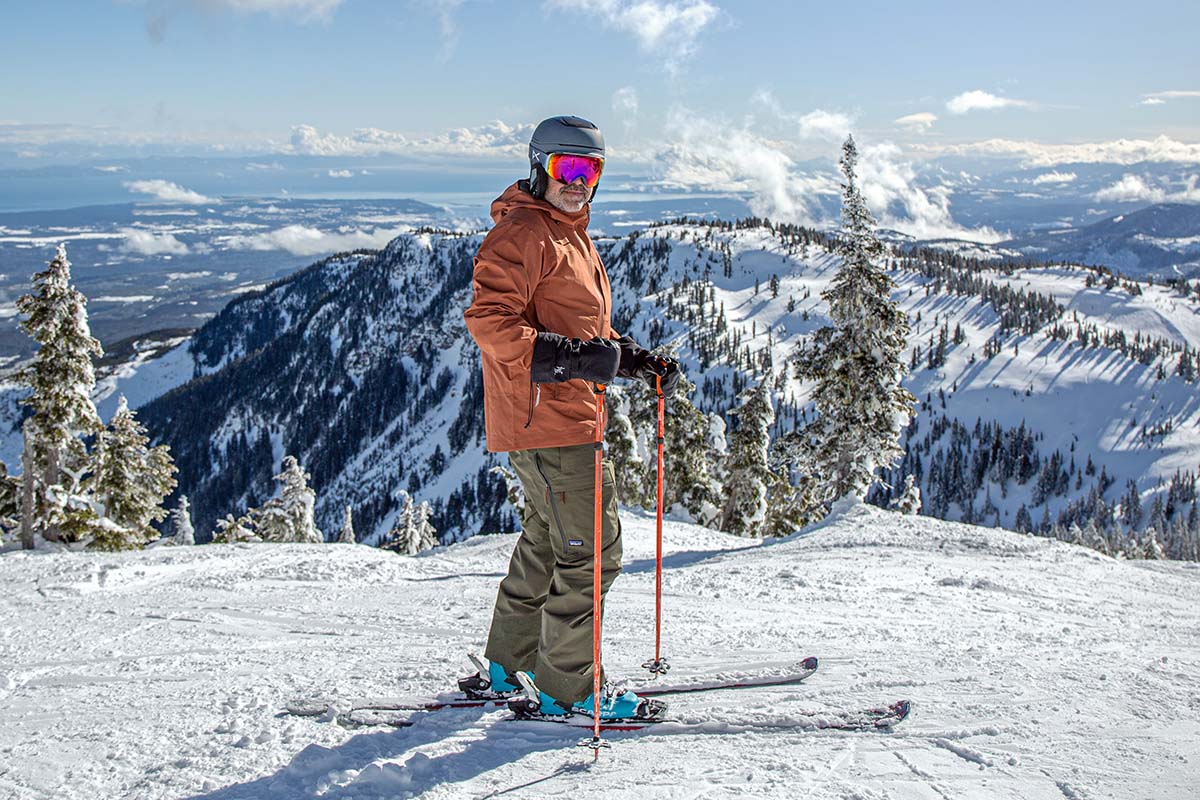
Your needs shift when traveling uphill on the skin track. Mobility is crucial, so backcountry-oriented pants often incorporate stretchy fabrics and an athletic cut for ease of movement. Breathability is also essential, with thinner materials and large zippered vents to help regulate temperature. Full weather protection is sometimes sacrificed to improve airflow, though whether this trade-off makes sense depends on your local climate and snow conditions. If you want a do-it-all pant, we recommend a fully waterproof model, such as the Arc'teryx Sabre and women's Sentinel, Trew Gear Chariot Bib Primo, or Norrøna Lofoten Gore-Tex.
.jpg)
Ski pants typically fall into one of three categories: hardshell, hardshell with mechanical stretch, or softshell. Your choice should align with where and how you ski: Hardshells are best for resort skiing, while stretchy fabrics are great for mogul skiing and uphill travel. The majority of skiers opt for a hardshell pant or hardshell with integrated stretch, but we also touch on softshell options below.
Hardshell
For most resort days, a traditional hardshell pant is the best choice. These provide excellent protection against wet snow and strong winds—ideal for extended chairlift rides—and premium models have impressive longevity. However, hardshells aren't particularly breathable and can have a relatively stiff and rigid feel. Fortunately, most modern designs include side vents to help release heat when necessary. The Flylow Chemical Pant is a standout, offering rugged 3-layer construction, a tough 150D face fabric, and generous venting on both the inner and outer legs.

Hardshell with Stretch
For aggressive resort skiers, sidecountry riders, and most backcountry enthusiasts, a waterproof pant with some added flexibility is a great middle ground. Options like the Patagonia Stormstride and Black Diamond Recon Stretch use a hardshell construction but integrate stretch into the fabric, providing a softer, less rigid feel with enhanced freedom of movement and breathability. However, there are trade-offs: Stretchy fabrics allow more airflow, making them less windproof, and they are more prone to wetting out with prolonged exposure. Still, for many backcountry skiers, stretch-infused hardshells offer the best balance of protection and comfort, which explains their growing popularity.
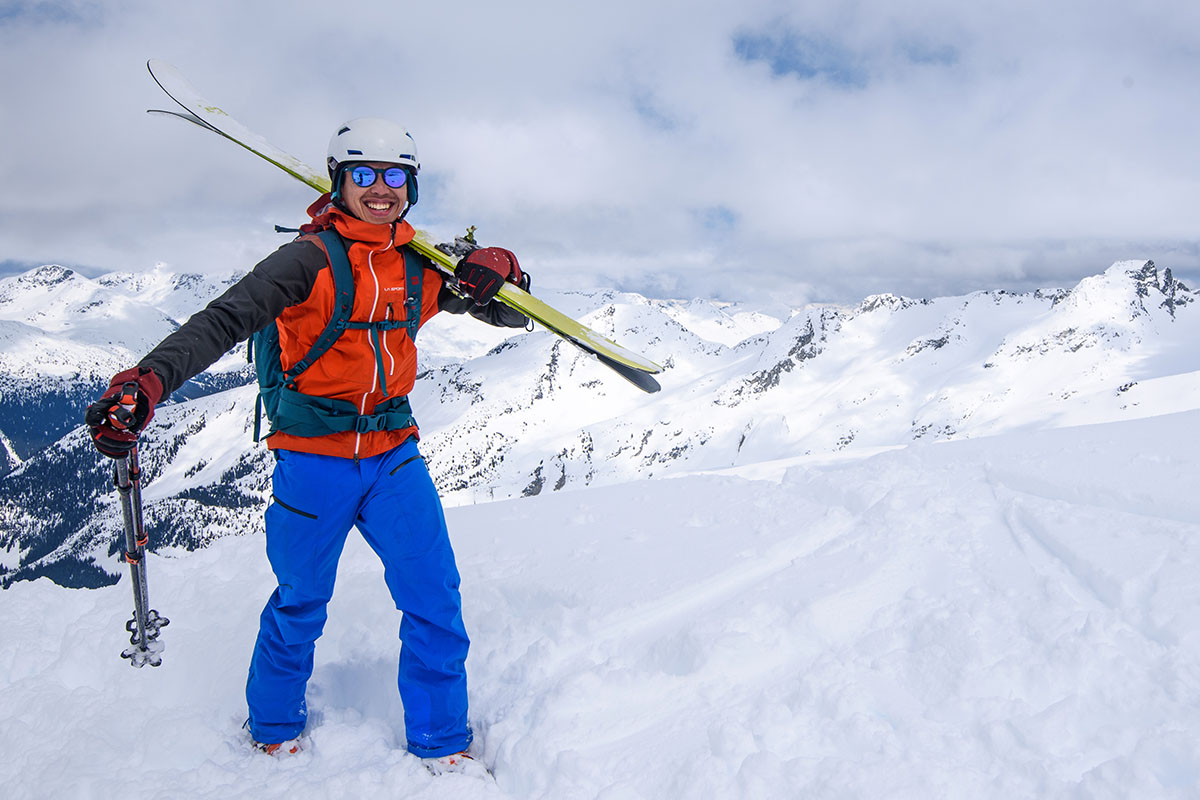
Softshell
For the utmost in breathability, we turn to softshell ski pants like the Outdoor Research Trailbreaker Tour (not included on our list), which features a softshell fabric above the knees. Softshells prioritize flexibility, air permeability, and next-to-skin comfort, making them ideal for high-output activities. However, they absorb moisture more readily than hardshells and often lack waterproof membranes. This makes them a poor choice for wet conditions—even prolonged contact with snow can lead to saturation—so they aren’t recommended for resort skiing or damp environments.

Ski pants generally fall into one of two categories: insulated models with built-in synthetic fill and uninsulated shell designs. Resort skiers, especially those sticking to groomed runs, can benefit from insulated pants, which provide extra warmth and act as a barrier against cold chairlift seats or snowy surfaces. Most insulated ski pants use synthetic fill, which is cost-effective and retains warmth even when wet (unlike goose or duck down). Insulation levels typically range from 40g to 80g of fill, with 60g being a safe middle ground—pants like the Helly Hansen Legendary strike a good balance for most skiers.
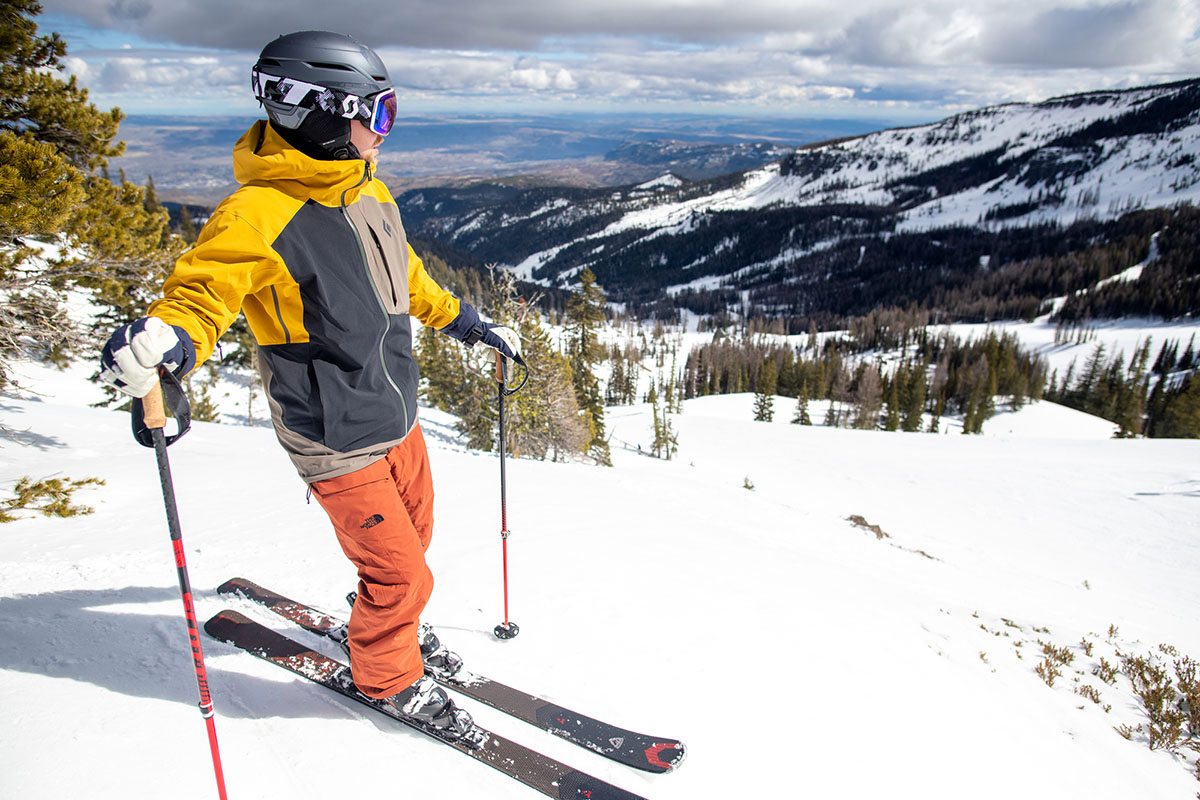
On the other hand, shell pants are better suited for aggressive skiers or those who frequent the backcountry. Without insulation, they’re less likely to cause overheating for mogul skiers, off-piste riders, or those hiking to find fresh snow. For ski touring, a shell pant is essential to help regulate body temperature. Another advantage of an uninsulated pant is the ability to customize warmth with different baselayers—choose a lightweight option for spring and active use or go with a mid- or heavyweight design when temperatures plummet. While most resort skiers will prefer the coziness of insulation, shell pants offer unmatched versatility for shifting conditions, varying levels of exertion, and season-long use.
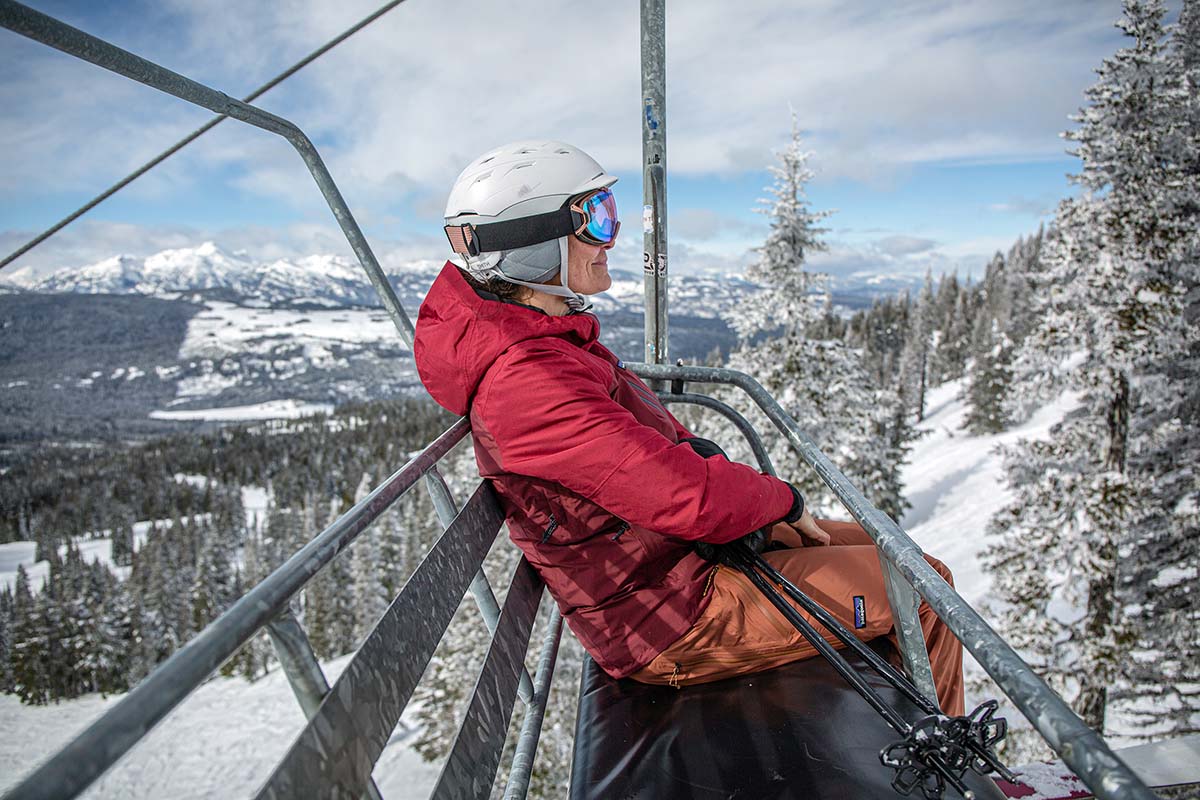
High-end ski pants typically feature a 3-layer construction, which consists of an outer shell, a waterproof/breathable membrane, and an inner liner bonded together. This setup reduces bulk compared to 2-layer designs, which require a separate hanging mesh liner. Additionally, 3-layer pants offer superior breathability and a more comfortable next-to-skin feel. Given these benefits, 3-layer models are the go-to choice for dedicated downhill and backcountry skiers.

More budget-friendly ski pants often use a 2-layer construction, which is less breathable but still quite durable. These are well suited for resort skiing, where ventilation is less of a priority (though mogul skiers or those who overheat easily may prefer a 3-layer design). A major advantage of 2-layer pants is affordability—some models start as low as $100 to $150, such as The North Face Freedom Pant ($170). By comparison, the least expensive 3-layer pants we recommend, Flylow's Donna and Chemical Pant, cost $365.
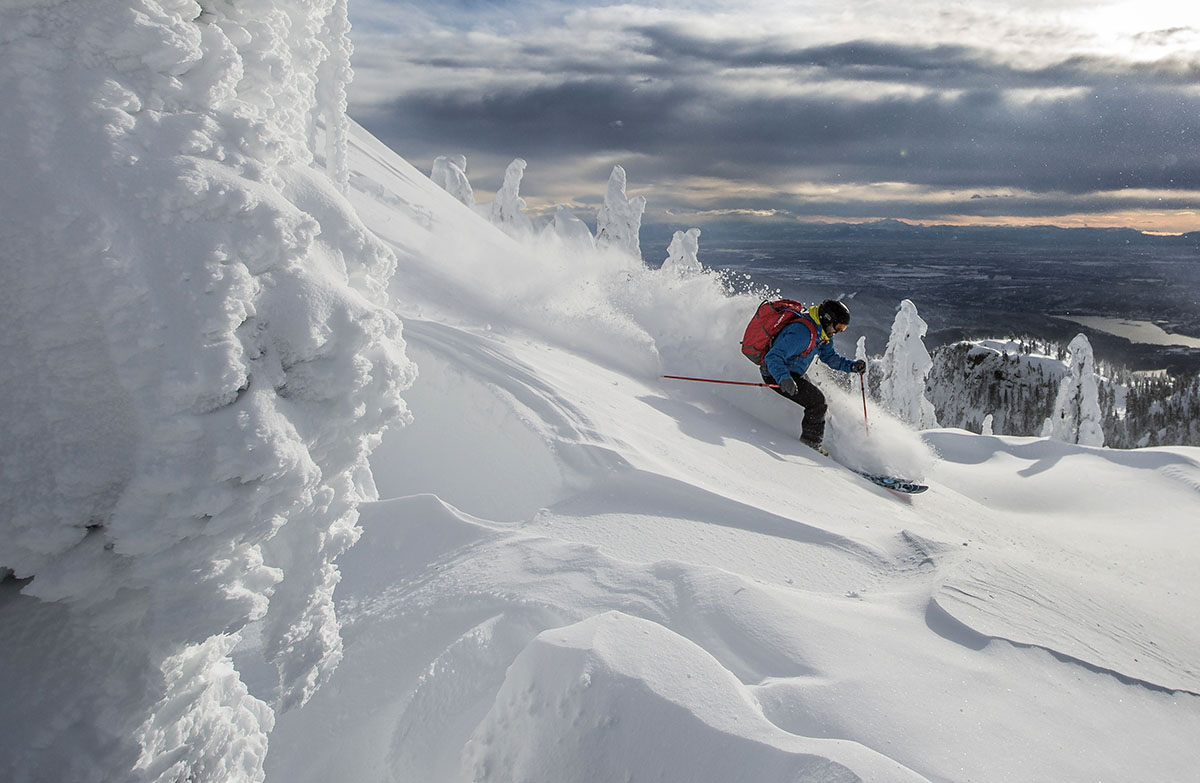
Dependable water resistance is essential for ski pants, as they come into frequent contact with snow. For the best protection, look for a hardshell model featuring Gore-Tex, eVent, or NeoShell. Mid-range and budget-friendly pants use in-house waterproofing technologies, which are still effective but may not be as durable. Additionally, features like seam taping and a DWR coating help prevent moisture from seeping in. Investing in a higher-quality pant often translates to better long-term performance and longevity.
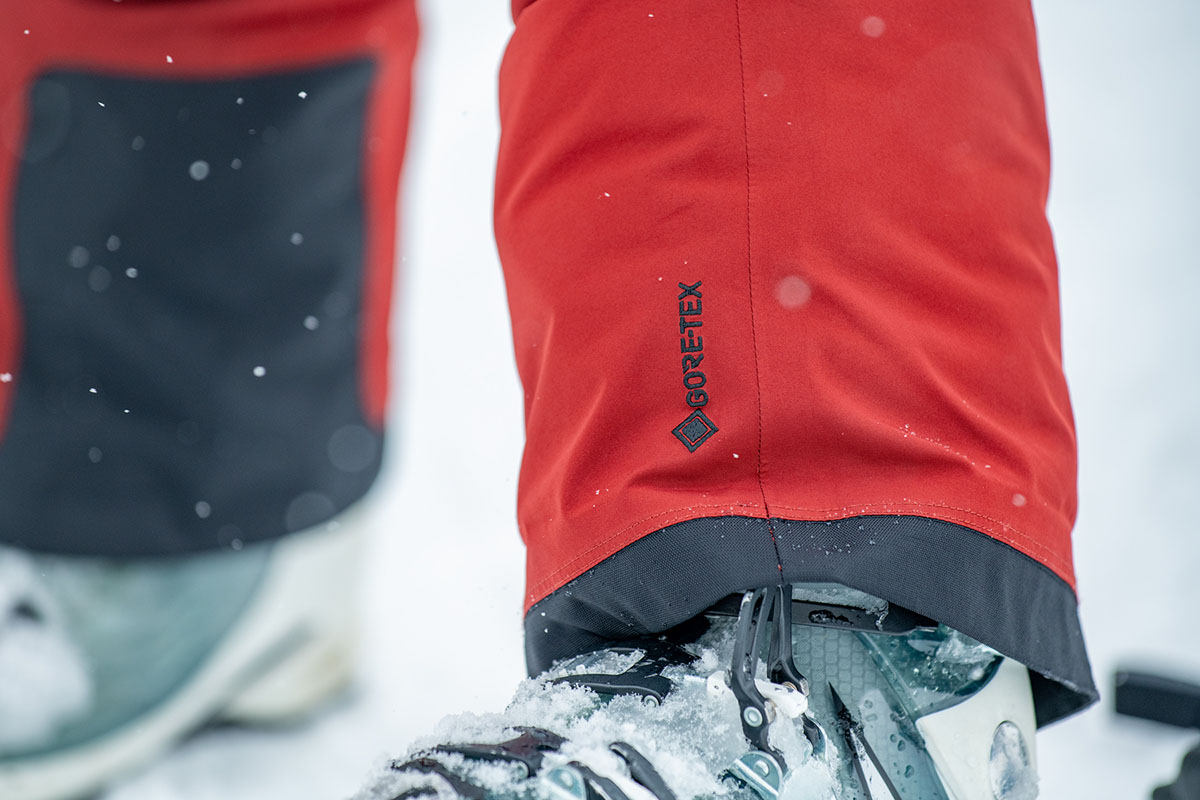
Backcountry skiers have different requirements and may not need full waterproofing. Since they spend less time sitting on chairlifts and more time actively moving, some prefer pants with only partial waterproofing or a highly water-resistant design. This is especially true in areas with drier snow, such as the Rocky Mountains. Consider your typical conditions before ruling out a pant with moderate water resistance.
.jpg)
The ideal level of breathability will depend on your skiing style. Resort skiers, particularly those staying on groomed runs, don’t require ultra-breathable pants—most standard 2-layer designs will suffice, and zippered vents can help release excess heat when needed. For those skiing primarily in the backcountry, breathability becomes much more critical. Among waterproof options, lightweight 3-layer constructions offer the best ventilation, with top choices including the Patagonia Stormstride and Black Diamond Recon Stretch. Some softshell-inspired designs offer even better airflow but sacrifice protection in harsh conditions. While this means a trade-off in wind and wet-weather resistance, breathable pants like the Stormstride and Recon Stretch are excellent for high-output activities.

Ski pants endure significant wear and tear, from boot buckles to ski edges and chairlifts, so durability is a key factor. The best way to gauge a pant’s toughness is by looking at the shell denier (D), which is a measurement of fabric thickness. Resort-focused pants tend to have high-denier fabrics, like the Patagonia Storm Shift (150D) and The North Face Freedom (140D x 160D), providing excellent durability. On the other hand, lightweight touring pants like the Patagonia Stormstride (40D) sacrifice some durability for increased mobility and comfort. Our top-rated pants, the Arc’teryx Sabre and women's Sentinel, strike a great balance with premium 80D shells. Many designs also include reinforced scuff guards along the inner cuff to protect against ski edges and general abrasion.
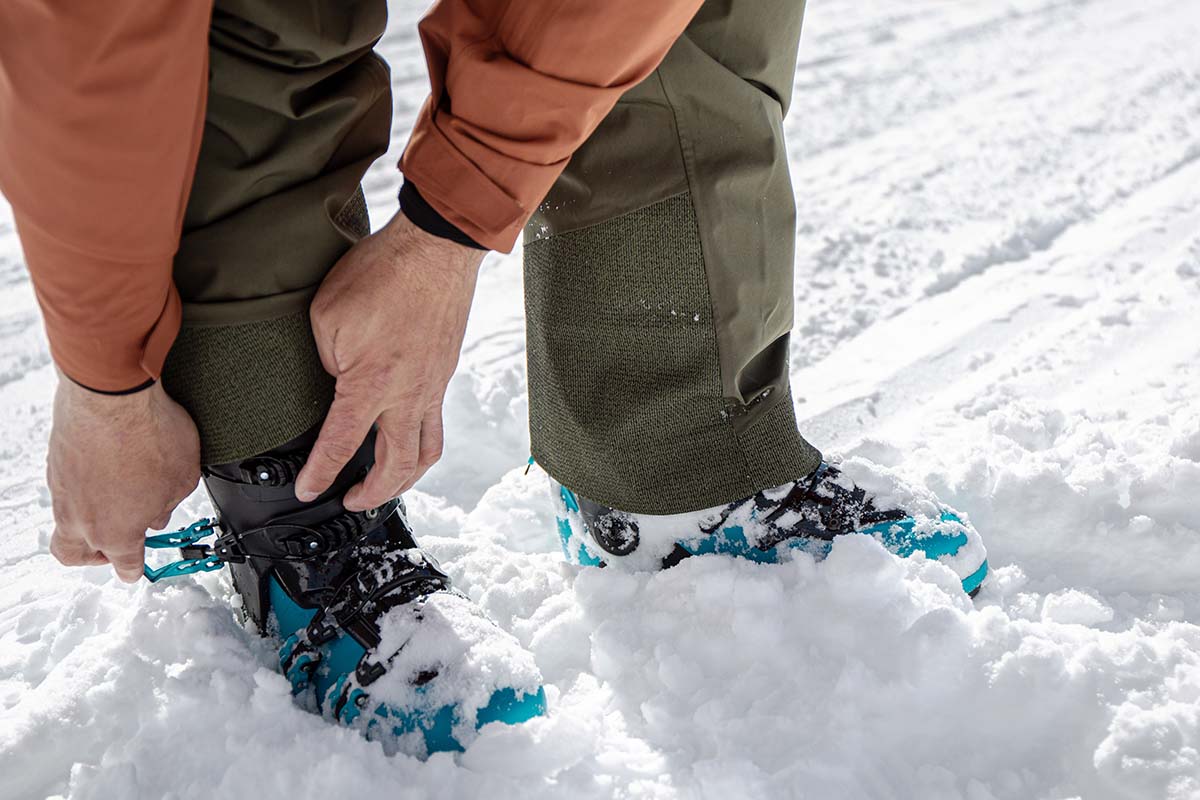
Another decision you'll have to make is whether to opt for traditional ski pants or higher-coverage ski bibs. Traditional pants are what most skiers are familiar with—they’re easy to put on and take off and perform well in both resort and backcountry settings. However, they don’t offer the same level of protection, as cold air and snow can creep in at the waist, particularly after a fall or on a windy chairlift ride.
Bibs solve these issues by providing better coverage against snow, wind, and moisture. They also offer additional warmth thanks to the extra fabric extending over your torso. Plus, they eliminate the discomfort of a waistband digging in, though the shoulder straps can take some getting used to, especially when paired with a backpack. For deep powder skiers or those prone to frequent tumbles, bibs can be a game-changer. Some of our favorite bibs include the Flylow Gear Baker, Trew Gear Chariot Primo, Flylow Gear Foxy, and REI First Chair GTX.
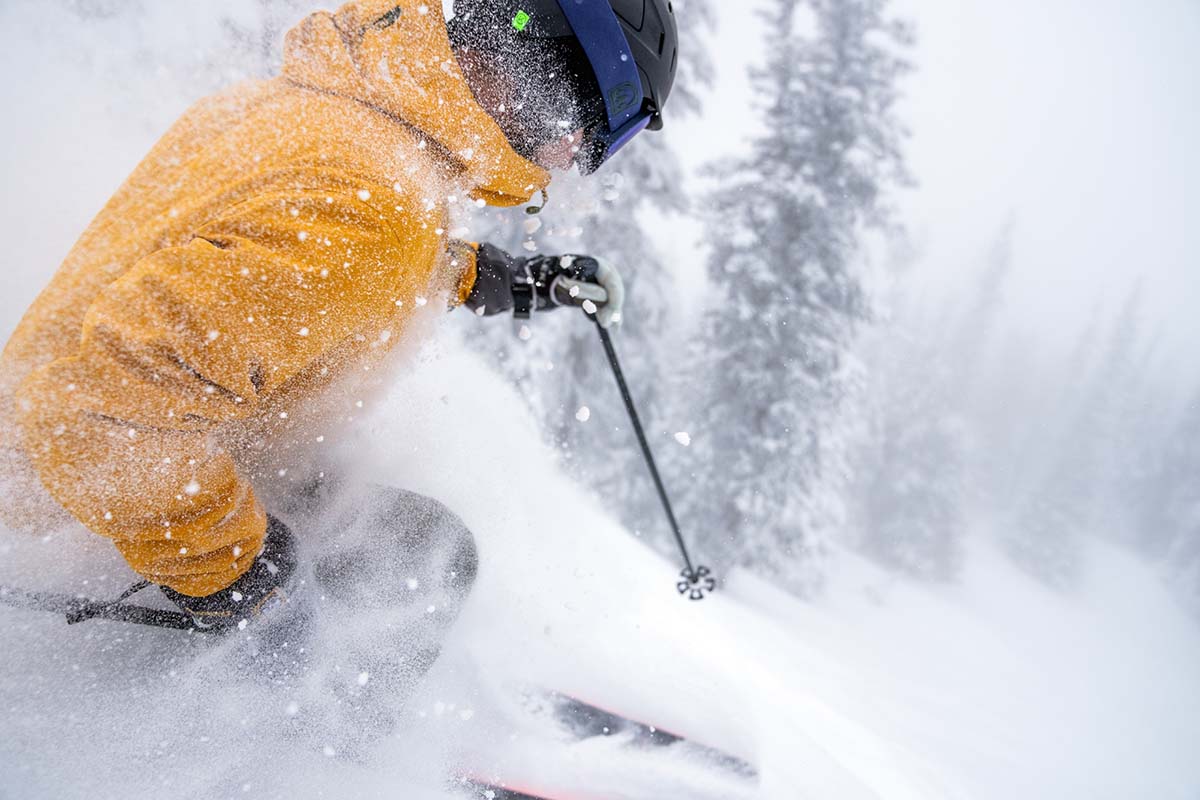
Pockets
Your ski jacket or backpack will likely be your main storage solution, but it’s still useful to check a pant’s pocket layout. We recommend opting for at least a couple of zippered pockets to stash small essentials like snacks or a ski pass. For resort skiing, we’re not big fans of bulky cargo pockets, as they can feel cumbersome while riding. Backcountry-oriented pants like the Patagonia Stormstride and Black Diamond Recon Stretch often feature specialized pockets designed for avalanche beacon.
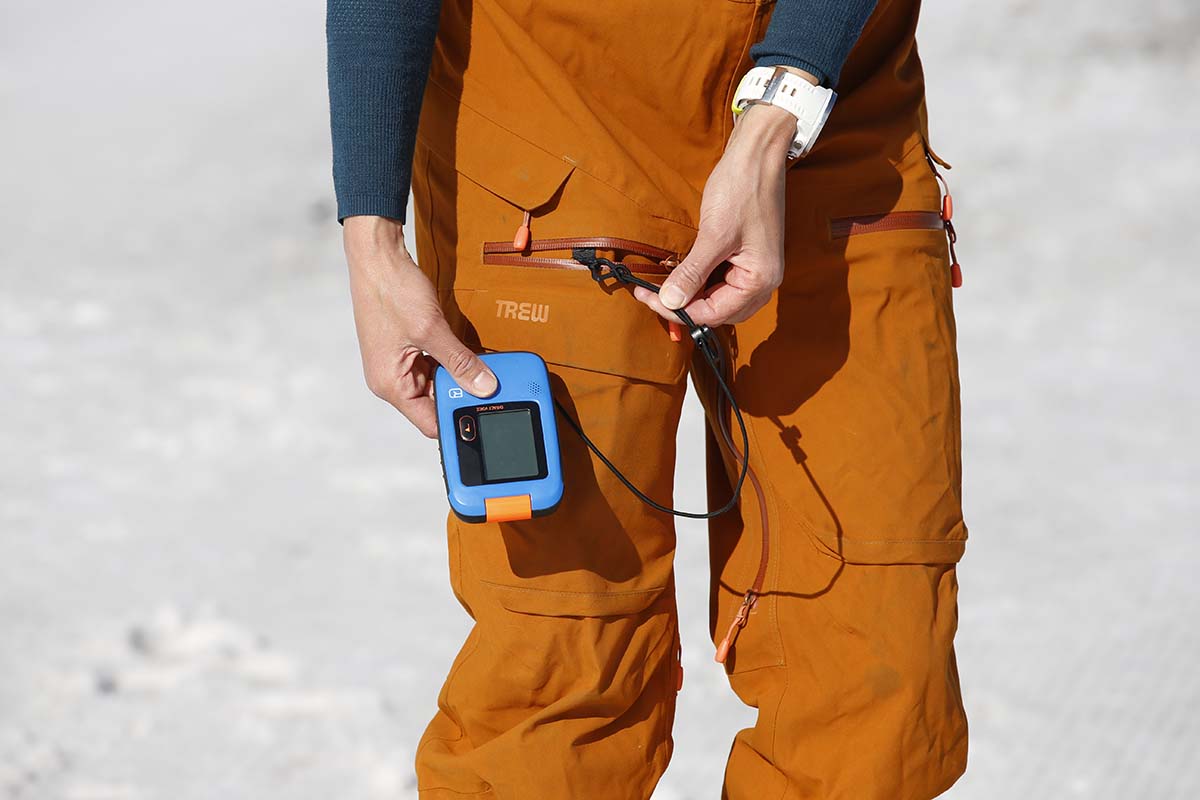
Ventilation
To enhance breathability, most ski pants feature zippered vents similar to pit zips found on jackets. These vents are typically positioned along the inner or outer thighs. Both styles help dump excess heat, though inner thigh vents can add bulk and sometimes reduce comfort. Many backcountry-specific pants favor outer thigh vents for better mobility. Some models, like the Flylow Gear Chemical and Donna pants, include vents on both sides of the leg for optimal cross-ventilation.

Recco
Some mid-range and high-end ski pants come equipped with a built-in Recco reflector, which is an added safety feature for those venturing into avalanche-prone terrain. Recco reflectors are passive units (no batteries required) that can be detected by Recco-equipped search-and-rescue teams. While not a replacement for an avalanche beacon, they provide an additional layer of security. If you want to learn more about the technology, the Recco System website offers helpful information.
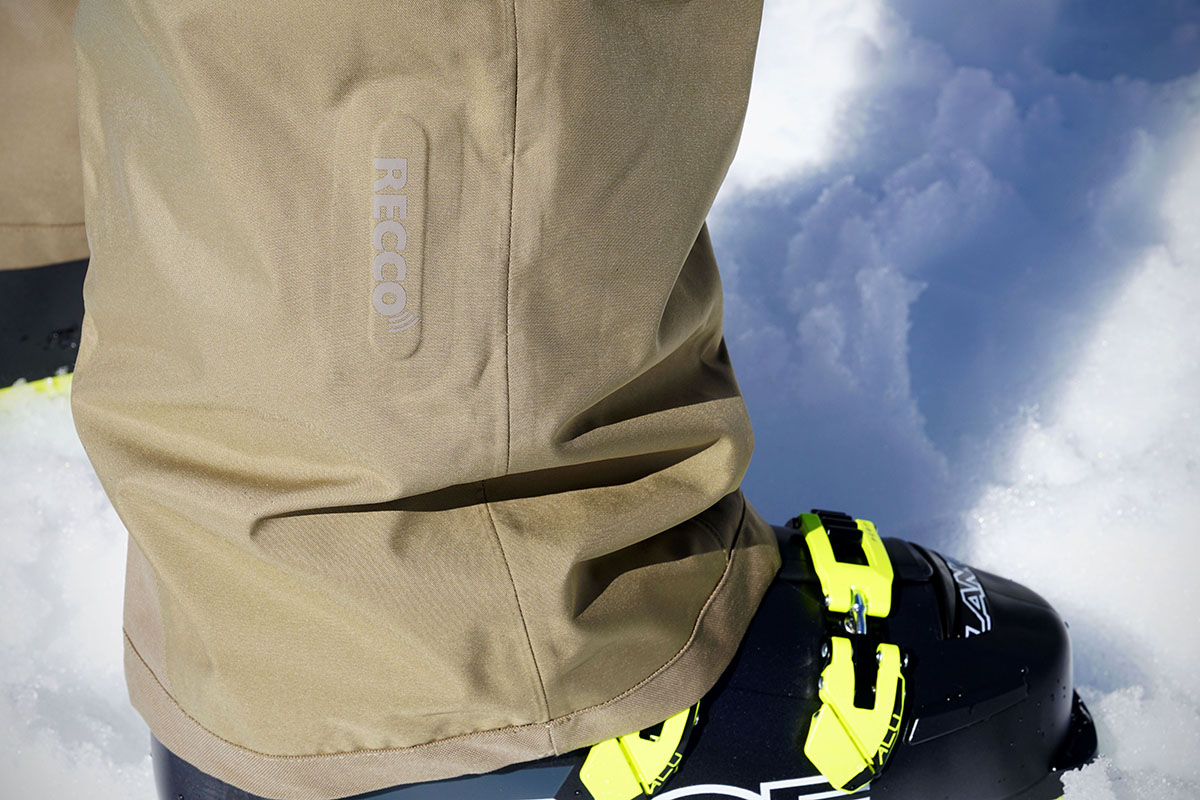
The best fit ultimately comes down to personal preference, but there are a few general points to consider. Beginner and intermediate downhill skiers tend to prefer a comfortable, relaxed fit that's neither too tight nor too baggy. Backcountry skiers often opt for a more streamlined, athletic cut for better uphill efficiency, while park skiers favor a looser fit for unrestricted movement. Our preference leans toward a slightly tailored design that maintains full mobility and leaves enough room for layering underneath.
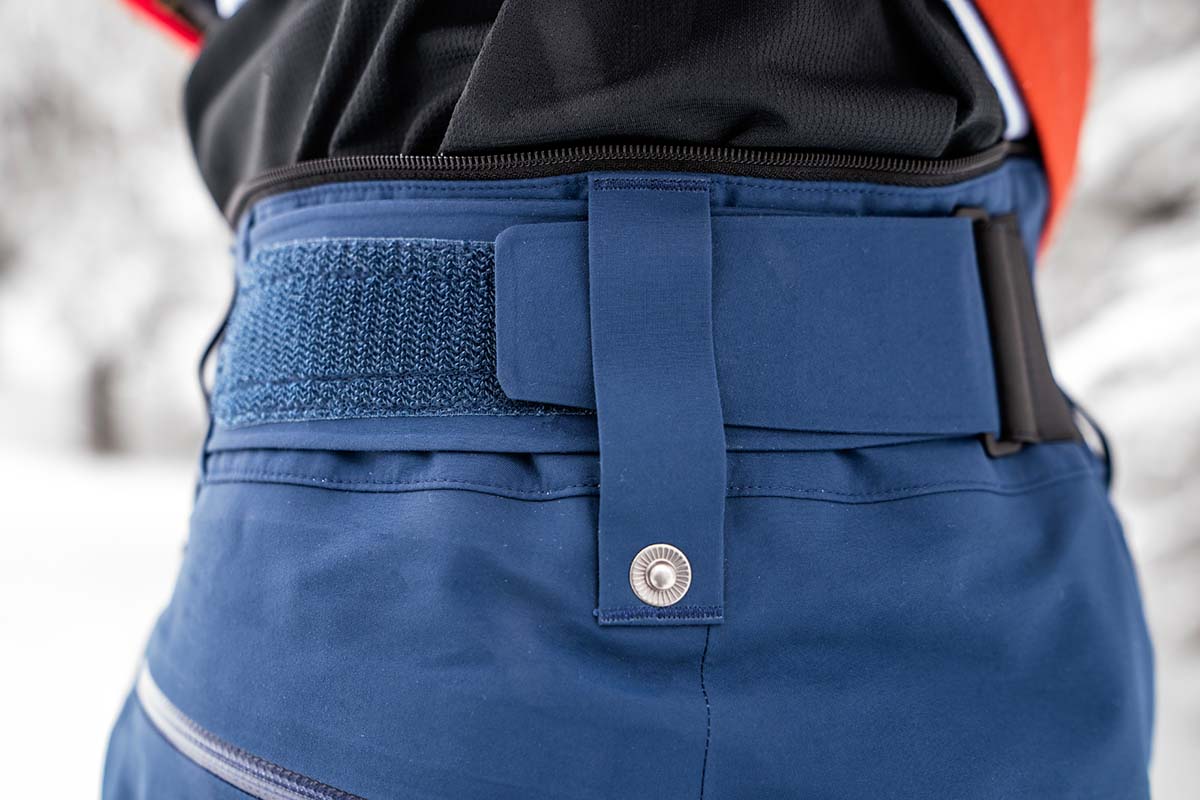
The ski apparel industry has seen notable inroads on the sustainability front in recent years, with brands like Patagonia and REI Co-op leading the charge. More ski pants now incorporate recycled materials, especially in shell and liner fabrics. Additionally, an increasing number of models, such as Patagonia’s latest Storm Shift and Powder Town collections, feature PFAS-free DWR coatings, reducing the environmental impact of harmful chemicals. Many brands also adhere to the bluesign system for responsible material sourcing and offer Fair Trade Certified-sewn products to ensure ethical labor practices. Another way to shop sustainably is by investing in high-quality gear built to last and taking advantage of repair programs rather than frequently replacing worn-out items. Patagonia, for instance, has a well-established repair program available both online and in stores.

While baselayers for your upper body get the most attention, what you wear under your ski pants is just as important. Wearing a thin pair of long underwear is almost always a good idea, whether skiing in the resort or backcountry. This extra layer provides insulation, wicks moisture away from your skin, and protects against cold chairlift seats and snowy falls. Additionally, many ski pant interiors have exposed mesh, zippers, or minimalist liners that can feel uncomfortable throughout a long day.

When selecting a baselayer, we recommend opting for a soft, snug-fitting design to maximize warmth and moisture management. The best options are made from synthetic materials or merino wool—avoid cotton, as it absorbs moisture and loses insulating properties when wet. Synthetics are the more affordable choice and excel at wicking sweat, but merino wool offers superior warmth and natural odor resistance. Baselayers come in different thicknesses: Lightweight options work well for warm spring days or high-output activities, while mid- and heavyweight models are best for colder conditions. On particularly frigid days, layering two baselayers can provide extra warmth.
Back to Our Top Ski Pant Picks Back to Our Ski Pant Comparison Table